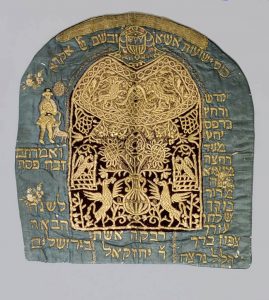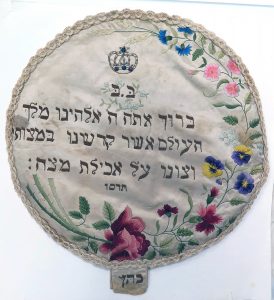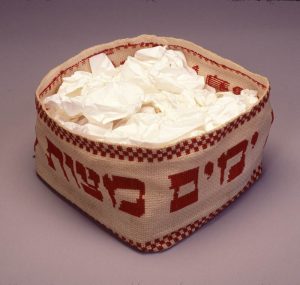Out of the Box: Four Unique Passover Items
At the Center for Jewish History, there are tens of thousands of boxes in our partners’ archival and museum collections. Our series, Out of the Box, showcases some of the remarkable treasures and stories tucked away inside. In collaboration with Yeshiva University Museum, we had intended this March to highlight just a few of the over 230 Passover items, which span over 200 years, that are carefully conserved in the Yeshiva University Museum’s collections.
Due to our temporary closure because of the coronavirus, we had to bring this conversation into the digital world. Bonni-Dara Michaels, the Collections Curator at the Yeshiva University Museum, was able to share with us a few of her favorite Passover items from the collections. Check out the video below, and then read our short interview with Bonni-Dara about what it’s like working with these unique artifacts!
 BONNI-DARA MICHAELS is Collections Curator of Yeshiva University Museum. She manages, documents and researches the Museum’s collection and has been with YUM since 1985. Michaels also develops and curates some of the Museum’s exhibitions including the current exhibition From A(gam) to Z(aritsky): Highlights of Israeli Art from YU Museum’s Collection and the 2016/17 exhibition Uncommon Threads: Clothing & Textiles from the YU Museum Collection. In addition to work on YUM publications, Michaels co-authored The Art of Passover with Gabriel Goldstein.
BONNI-DARA MICHAELS is Collections Curator of Yeshiva University Museum. She manages, documents and researches the Museum’s collection and has been with YUM since 1985. Michaels also develops and curates some of the Museum’s exhibitions including the current exhibition From A(gam) to Z(aritsky): Highlights of Israeli Art from YU Museum’s Collection and the 2016/17 exhibition Uncommon Threads: Clothing & Textiles from the YU Museum Collection. In addition to work on YUM publications, Michaels co-authored The Art of Passover with Gabriel Goldstein.
Q: Why did you want to become a museum curator?
BDM: By the time I was in my early teens, I was interested in museum work. I was fascinated by objects I saw in museums because they told so much about different cultures, and how different people approached the same concept in different ways: this is what a person looks like, this is how a person relates to a horse, whether it’s a painting or a Chinese tomb sculpture. So, I took courses at the Met, and in college I did a lot of summer and vacation volunteering, and learned how to be a museum curator.
Q: How does a museum decide what donated objects to take in?
BDM: We no longer have things walk in and get shown what they are. We don’t get to interact with them and say, “Oh, how beautiful, tell me the story about this…” That is how it used to be. Somebody would make an appointment with me come in, bring Grandma’s matza cover or Grandpa’s Kiddish cup. Sometimes I would go to somebody’s house, when they were cleaning up or preparing to move. Those were always the most fun for me. I would go to a house or apartment and spend – sometimes a couple of days, scrounging through people’s closets and going, “Oh, look! This is a painting done on velvet done in the Bezalel School [of Art and Design].” Frequently, people don’t even know what they have. One time, I walked into an apartment, and I said, “Do you people realize you have a Georg Jensen mezuzah on the door?” And they said, “No! Wait – Georg Jensen?!”
 These days, there’s a lot more people wanting to get their Grandma’s piece donated to a museum. Somebody will send us a picture of something and then several times a year, we have a Collections Committee that meets and goes through the items. Part of my job is to write about the pieces we’ve been offered – the history of each piece, why and where it was made, how it was made, why it is important, this is how it fits into our collection because we don’t have another like it, or because it is very different from other pieces we already have in our collection. For example, the Bergazin matza cover (timestamp – 2:27), we did have matza covers in the collection, but we didn’t have an early 20th century one that was that beautifully embroidered, that spoke about the patterns in ladies magazines that the woman would have borrowed to make the flowers and wheat. Then, I present it to the Collections Committee, and we decide what to take in.
These days, there’s a lot more people wanting to get their Grandma’s piece donated to a museum. Somebody will send us a picture of something and then several times a year, we have a Collections Committee that meets and goes through the items. Part of my job is to write about the pieces we’ve been offered – the history of each piece, why and where it was made, how it was made, why it is important, this is how it fits into our collection because we don’t have another like it, or because it is very different from other pieces we already have in our collection. For example, the Bergazin matza cover (timestamp – 2:27), we did have matza covers in the collection, but we didn’t have an early 20th century one that was that beautifully embroidered, that spoke about the patterns in ladies magazines that the woman would have borrowed to make the flowers and wheat. Then, I present it to the Collections Committee, and we decide what to take in.
Q: What is it like to share these beautiful objects with the public?
BDM: I don’t like to say that they’re all beautiful. If you look at the matza container (timestamp – 3:47), it’s fairly plain, especially in comparison to the other pieces that are richly decorated. Sometimes, though, these are the ones that are closer to my heart. The plainer ones, the ugly ducklings, the pieces that are different or are more for daily use – these are the ones I have the most fun presenting to the public.
 It’s easier to present something like the Galician textile (timestamp – 0:30) or the sederzwehl (timestamp – 1:15 ). It’s something different it’s very elaborately decorated, it’s very pretty, it has all these fine details in it. And someone did work on it, although I think it was likely a professional. But the simpler items that are more likely to be done by the woman at home in her free time, because you’re not supposed to sit there with idle hands, those can be the ones that resonate the most with me. The woman at home – perhaps unhappy she had to do all this embroidery and she’s going to do the least she can do, or maybe her skills are not as developed as somebody else’s and so she may be working with even more effort. I can feel the person doing it.
It’s easier to present something like the Galician textile (timestamp – 0:30) or the sederzwehl (timestamp – 1:15 ). It’s something different it’s very elaborately decorated, it’s very pretty, it has all these fine details in it. And someone did work on it, although I think it was likely a professional. But the simpler items that are more likely to be done by the woman at home in her free time, because you’re not supposed to sit there with idle hands, those can be the ones that resonate the most with me. The woman at home – perhaps unhappy she had to do all this embroidery and she’s going to do the least she can do, or maybe her skills are not as developed as somebody else’s and so she may be working with even more effort. I can feel the person doing it.



1 comment